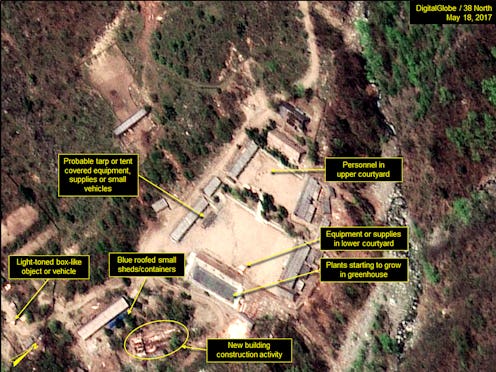News
A Tunnel Collapsed At A North Korean Nuclear Site & 200 People Are Reportedly Dead

On Tuesday, Japanese media outlet Asahi TV reported that some 200 people died at a North Korea nuclear test site after a tunnel collapsed. The Japanese network cited sources in North Korea who claimed that around 100 workers were at the Punggye-ri nuclear test site — which sits beneath Mount Mantap — when the tunnel first collapsed early in October. About 100 more workers were sent there to help them, but they were reportedly killed, too, when the tunnel collapsed again.
It's unclear when the accident happened. Multiple outlets state that Asahi TV reported the first collapse in October, but Reuters stated the initial incident happened "around Sept. 10." Reuters noted it was not able to verify the report.
Last month, North Korea said it had tested a hydrogen bomb at Punggye-ri. The alleged hydrogen bomb test was just the latest antagonistic and tension-escalating gesture between North Korea and the United States, and according to reports, its feared that the collapse may have coincided with a major radiation leak, stoking concerns about a widespread environmental disaster in the mold of what happened in Fukushima, Japan back in 2011.
Mount Mantap, the mountain under which the collapse reportedly occurred, is part of the Hamgyong mountain range, which sits in the northeast corner of the isolated nation.
The specter of a hydrogen bomb test was referenced by North Korean foreign minister Ri Yong Ho last month, following a decidedly heavy, combative address at the United Nations General Assembly. Ri's speech was a response to President Trump's earlier aggressive U.N. speech directed at North Korea, in which he warned the United States would move to "totally destroy" the country if its provocations, specifically in the form of nuclear tests and intercontinental ballistic missile tests, continued.
Now, it appears as if the weapons testing has had an unexpected human cost within North Korea. These reports are originally sourced to Japanese media, with TV Asahi quoting anonymous sources within North Korea. Japan, along with the other major U.S. ally in the region, South Korea, have for years been the countries most under threat from North Korea's aggressive weapons testing and technological advancements, although it's now believed that the North has ICBMs which could theoretically reach the United States.
Just last week, North Korean official Ri Yong Pil told CNN that his country's threats to conduct an above-ground nuclear test should be taken "literally," echoing the foreign minister's threats in September about a possible hydrogen bomb test in the Pacific Ocean.
North Korean threats towards the United States and its allies are nothing new in historical terms, as the leadership (previously in the form of dictator Kim Jong-un's father Kim Jong-il) has made hyperbolic and lurid threats for years, since long before they had anywhere near the missile capabilities they're believed to now. in fact, the country's common threat to turn the U.S. into a "sea of fire" is one it's been using since at least 2003.
The major difference in the dynamic is that there's now an American president who's been reflecting back and amplifying that sort of harrowing language, threatening to bring down "fire and fury" against North Korea, ramping up tensions rather than trying to smooth them over. Trump has also taken to derisively referring to Kim Jong-un as "Rocket Man," a taunt he first unveiled on Twitter, then pulled out during his aforementioned U.N speech.
Punggye-ri is the only North Korean nuclear site that's location and existence is a matter of public knowledge, and is reportedly the site at which all six of the country's known nuclear tests to-date have taken place. Chinese geologists are reportedly concerned about the collapse and the ongoing potential instability of the site, fearful that another explosion could collapse the entire mountain and send radioactivity across the border into China.
It's notoriously difficult to get accurate and verifiable reporting form out of North Korea, known colloquially to some as the Hermit Kingdom for its stark isolation on the world stage. According to Japanese media, however, this incident had already brought a significant human cost, and could be a major environmental crisis in the making.
Clarissa-Jan Lim contributed to this report.